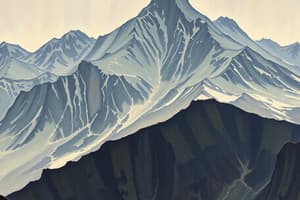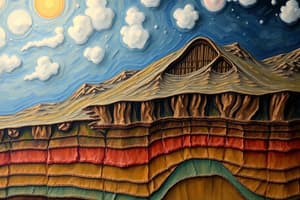Podcast
Questions and Answers
What is the outermost layer of the Earth called?
What is the outermost layer of the Earth called?
- Inner Core
- Crust (correct)
- Outer Core
- Mantle
Which layer of the Earth is primarily composed of liquid?
Which layer of the Earth is primarily composed of liquid?
- Crust
- Mantle
- Outer Core (correct)
- Inner Core
What causes the movement of tectonic plates?
What causes the movement of tectonic plates?
- The density of the inner core
- The thickness of the crust
- Convection currents (correct)
- Plate Tectonic Theory
What is referred to as the area where two tectonic plates meet?
What is referred to as the area where two tectonic plates meet?
In which tectonic boundary do two plates move away from each other?
In which tectonic boundary do two plates move away from each other?
What occurs during subduction?
What occurs during subduction?
Which layer of the Earth is the thickest?
Which layer of the Earth is the thickest?
Which layer of the Earth is solid despite the high temperatures?
Which layer of the Earth is solid despite the high temperatures?
What characterizes active faults?
What characterizes active faults?
What does the intensity of an earthquake measure?
What does the intensity of an earthquake measure?
What type of fault is characterized by a vertical movement?
What type of fault is characterized by a vertical movement?
What can compression force cause in geological formations?
What can compression force cause in geological formations?
Which of the following defines the focus of an earthquake?
Which of the following defines the focus of an earthquake?
What are body waves?
What are body waves?
Which type of seismic waves are directly above the focus?
Which type of seismic waves are directly above the focus?
What describes an oblique-slip fault?
What describes an oblique-slip fault?
Flashcards
Crust
Crust
The outermost and thinnest layer of the Earth, approximately 50 km thick, made up of different landforms.
Mantle
Mantle
Layer beneath the crust, the thickest layer (2900 km), containing the asthenosphere.
Outer Core
Outer Core
Liquid layer of Earth primarily composed of iron and nickel, 2200 km thick, at a temperature of 5000°C.
Inner Core
Inner Core
Signup and view all the flashcards
Tectonic Plates
Tectonic Plates
Signup and view all the flashcards
Plate Boundary
Plate Boundary
Signup and view all the flashcards
Convergent Boundary
Convergent Boundary
Signup and view all the flashcards
Divergent Boundary
Divergent Boundary
Signup and view all the flashcards
Transform Boundary
Transform Boundary
Signup and view all the flashcards
Subduction
Subduction
Signup and view all the flashcards
Plate Tectonic Theory
Plate Tectonic Theory
Signup and view all the flashcards
Convection Currents
Convection Currents
Signup and view all the flashcards
Active Fault
Active Fault
Signup and view all the flashcards
Inactive Fault
Inactive Fault
Signup and view all the flashcards
Earthquake
Earthquake
Signup and view all the flashcards
Fault
Fault
Signup and view all the flashcards
Dip-slip Fault
Dip-slip Fault
Signup and view all the flashcards
Normal Fault
Normal Fault
Signup and view all the flashcards
Reverse Fault
Reverse Fault
Signup and view all the flashcards
Thrust Fault
Thrust Fault
Signup and view all the flashcards
Strike-slip Fault
Strike-slip Fault
Signup and view all the flashcards
Left-lateral
Left-lateral
Signup and view all the flashcards
Right-lateral
Right-lateral
Signup and view all the flashcards
Oblique-slip fault
Oblique-slip fault
Signup and view all the flashcards
Hanging Wall
Hanging Wall
Signup and view all the flashcards
Footwall
Footwall
Signup and view all the flashcards
Compression
Compression
Signup and view all the flashcards
Tension
Tension
Signup and view all the flashcards
Shearing
Shearing
Signup and view all the flashcards
Seismic Wave
Seismic Wave
Signup and view all the flashcards
Focus (of an earthquake)
Focus (of an earthquake)
Signup and view all the flashcards
Epicenter
Epicenter
Signup and view all the flashcards
Intensity
Intensity
Signup and view all the flashcards
Magnitude
Magnitude
Signup and view all the flashcards
Study Notes
Layers of the Earth
- Crust: Outermost, thinnest layer (50km), composed of different landforms.
- Mantle: Beneath the crust, thickest layer (2900km), solid rock. Contains the asthenosphere.
- Outer Core: Liquid layer, composed of iron and nickel (2200km), 5000°C.
- Inner Core: Solid, densest layer (1200km), 6000°C.
Tectonic Plates
- Tectonic Plates: Large sections of rock within the lithosphere.
- Plate Boundaries: Where two plates meet.
- Plate Tectonic Theory: Earth's crust is made up of moving plates driven by convection currents in the mantle.
- Types of Plate Movement: Plates can move towards each other (convergent), away from each other (divergent), or slide past each other (transform).
Types of Tectonic Boundaries
- Convergent (Destructive): Two plates move together, one may be driven down into the mantle (subduction).
- Divergent (Constructive): Two plates move apart.
- Transform (Conservative): Two plates slide past each other.
Earthquakes
- Active Faults: Generated earthquakes in the past 10,000 years; may still generate earthquakes.
- Inactive Faults: Show no signs of generating earthquakes in the past 10,000 years; may potentially generate earthquakes in the future.
- Earthquake Causes: Sudden movement along fractures in the Earth's crust known as faults, releasing energy from beneath the ground.
- Intensity: Measure of damage caused by an earthquake.
- Magnitude: Total amount of energy released by the earthquake.
- Faults: Fractures or breaks in the earth's crust where earthquakes are likely to occur.
- Types of Faults: Vertical movement (dip-slip) such as normal, reverse, thrust faults and horizontal movement (strike-slip) such as left lateral, right lateral and oblique-slip faults.
Seismic Waves
- Seismic Waves: Waves of energy caused by the sudden breaking of rock within the earth.
- Types of Seismic Waves: Body waves (travel through the Earth's interior: P-waves and S-waves), and Surface waves (travel on Earth's surface: Love waves and Rayleigh waves). Body waves arrive first, followed by surface waves, which cause the most damage.
Measuring Earthquakes
- Mercalli Scale: Measures intensity of an earthquake based on the observed effects.
- Richter Scale: Measures the magnitude of an earthquake; logarithmic scale.
- Seismogram: A record of ground motion during an earthquake, used to determine magnitude and type of earthquake.
- Seismograph: Instrument used to measure earthquake waves.
Studying That Suits You
Use AI to generate personalized quizzes and flashcards to suit your learning preferences.




